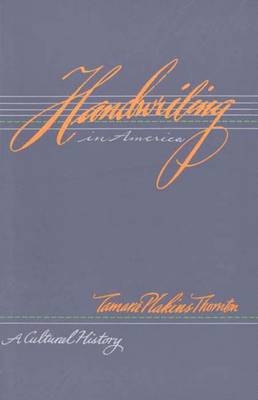
Handwriting in America
A Cultural History
Seiten
1998
Yale University Press (Verlag)
978-0-300-07441-3 (ISBN)
Yale University Press (Verlag)
978-0-300-07441-3 (ISBN)
- Titel z.Zt. nicht lieferbar
- Portofrei ab CHF 40
- Auch auf Rechnung
- Artikel merken
In this history, Tamara Plakins Thornton traces handwriting in America from colonial times to the present.
Copybooks and the Palmer method, handwriting analysis and autograph collecting—these words conjure up a lost world, in which people looked to handwriting as both a lesson in conformity and a talisman of individuality. In this engaging history, ranging from colonial times to the present, Tamara Plakins Thornton explores the shifting functions and meanings of handwriting in America.
Script emerged in the eighteenth century as a medium intimately associated with the self, says Thornton, in contrast to the impersonality of print. But thereafter, just what kind of self would be defined or revealed in script was debated in the context of changing economic and social realities, definitions of manhood and womanhood, and concepts of mind and body. Thornton details the parties to these disputes: writing masters who used penmanship training to form and discipline character; scientific experts who chalked up variations in script to mere physiological idiosyncrasy; and autograph collectors and handwriting analysts who celebrated signatures that broke copybook rules as marks of personality, revealing the uniqueness of the self. In our time, concludes Thornton, when handwriting skills seem altogether obsolete, calligraphy revivals and calls for old-fashioned penmanship training reflect nostalgia and the rejection of modernity.
Copybooks and the Palmer method, handwriting analysis and autograph collecting—these words conjure up a lost world, in which people looked to handwriting as both a lesson in conformity and a talisman of individuality. In this engaging history, ranging from colonial times to the present, Tamara Plakins Thornton explores the shifting functions and meanings of handwriting in America.
Script emerged in the eighteenth century as a medium intimately associated with the self, says Thornton, in contrast to the impersonality of print. But thereafter, just what kind of self would be defined or revealed in script was debated in the context of changing economic and social realities, definitions of manhood and womanhood, and concepts of mind and body. Thornton details the parties to these disputes: writing masters who used penmanship training to form and discipline character; scientific experts who chalked up variations in script to mere physiological idiosyncrasy; and autograph collectors and handwriting analysts who celebrated signatures that broke copybook rules as marks of personality, revealing the uniqueness of the self. In our time, concludes Thornton, when handwriting skills seem altogether obsolete, calligraphy revivals and calls for old-fashioned penmanship training reflect nostalgia and the rejection of modernity.
| Erscheint lt. Verlag | 1.6.1998 |
|---|---|
| Zusatzinfo | 57 b-w illus. |
| Sprache | englisch |
| Maße | 152 x 229 mm |
| Gewicht | 476 g |
| Themenwelt | Geschichte ► Hilfswissenschaften ► Paläografie |
| Geisteswissenschaften ► Sprach- / Literaturwissenschaft ► Sprachwissenschaft | |
| Sozialwissenschaften | |
| ISBN-10 | 0-300-07441-7 / 0300074417 |
| ISBN-13 | 978-0-300-07441-3 / 9780300074413 |
| Zustand | Neuware |
| Haben Sie eine Frage zum Produkt? |
Mehr entdecken
aus dem Bereich
aus dem Bereich
Schnelle Hilfe bei häufigen Fehlern
Buch | Softcover (2021)
UTB (Verlag)
CHF 25,20
Buch | Hardcover (2023)
Reichert, L (Verlag)
CHF 307,95


